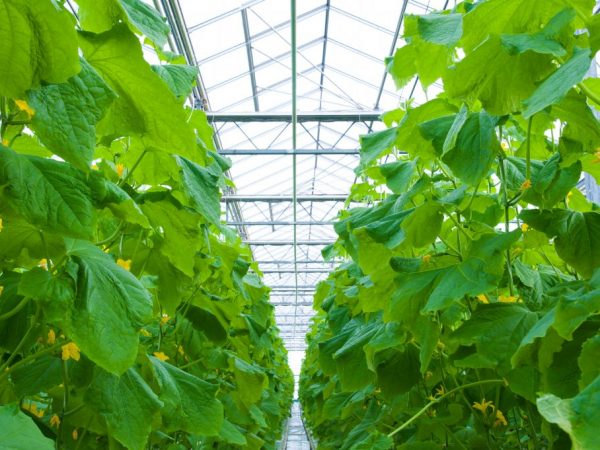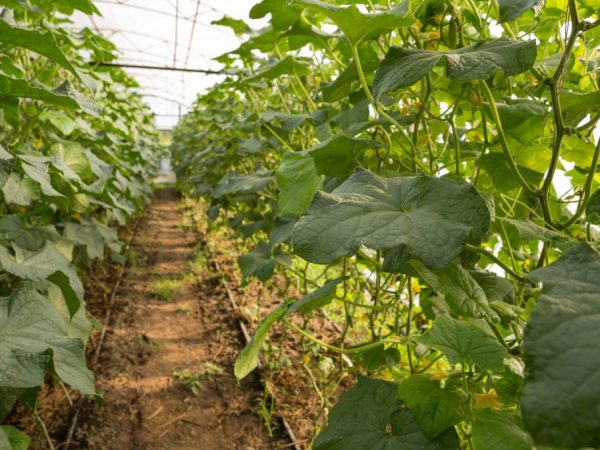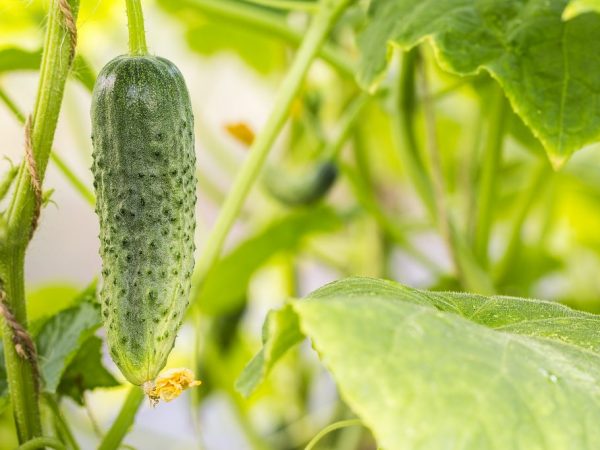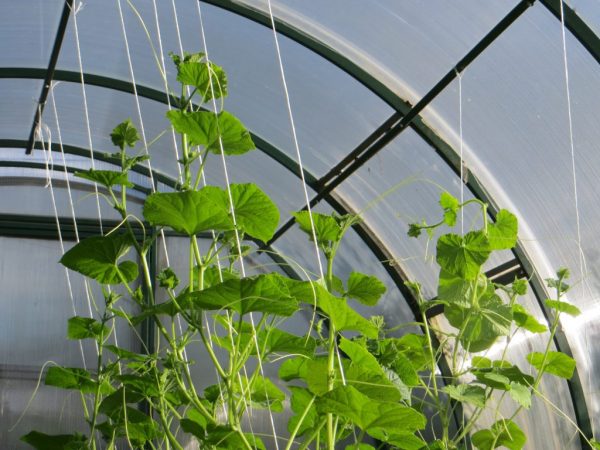Growing cucumbers in a greenhouse in winter
Growing cucumbers in a greenhouse in winter has long been used on an industrial scale and is gaining popularity among summer residents. There are varieties bred specifically for cultivation in regions with cold climates for winter fruiting. The technology of growing cucumbers in a greenhouse or greenhouses in winter with sufficient heating is successful all over the world.
- Greenhouse design requirements
- Foundation and frame
- Roof
- input
- Greenhouse heating and ventilation
- Heating
- Ventilation
- Equipping the greenhouse with lighting
- Soil preparation
- Priming
- Suitable varieties
- Dignity
- Seed preparation
- Calibration
- Treatment
- Warming up
- Hardening
- Stimulation
- Planting and leaving
- Correct fit and optimal mode
- Care
- Watering
- Fertilizer
- Formation of bushes
- Harvesting

Growing cucumbers in a greenhouse in winter
Greenhouse design requirements
For the winter cultivation of cucumbers, a greenhouse must meet a number of requirements:
- proper heating of the soil and air,
- correct moisture readings,
- the presence of an artificial light source,
- fertile loose land.
Such conditions for growing cucumbers in winter are provided by greenhouses made of glass or polycarbonate. Greenhouses covered with a film over the entire width are not suitable for winter cultivation of vegetable crops: the film coating is fragile, and during heavy snowfalls, the structure sags, snow accumulates on the film and can collapse at any time.
Foundation and frame
If you design the right greenhouse for growing cucumbers in winter, it is best to use a solid concrete foundation as the base. Structures buried in the soil act as an additional natural insulation.
The height of the greenhouse is selected so as to maintain the proportion of the sown area and volume of 2: 1.
The frame can be made from a wooden base or metal pipes. The greenhouses with double frames and a slope of the wall from the south side showed the greatest efficiency and ease of use.
Roof
The greenhouse roof is made of the same material as the entire greenhouse. Its tilt is determined by the angle of the sun. The most suitable option would be the passage of the sun's rays at a right angle at noon.
input
It is advisable to enter the winter greenhouse through a small vestibule. This will protect the cucumber bushes from the sharp influx of cold air. The tambour can also serve as a utility room, where a water storage and heating equipment are located.
Greenhouse heating and ventilation
A properly assembled structure must be equipped with ventilation and heating systems in order to grow cucumbers in winter at the required optimal mode.
Heating
When planning a heating system for a greenhouse for growing cucumbers in winter, you need to remember that this vegetable crop does not tolerate excessively dry air, therefore convectors, metal stoves and oil heaters are not used as heat sources in the greenhouse. One of the suitable heating options in winter would be a water heating system through pipes laid in the soil. The air is heated by radiators or registers stretched along the greenhouse perimeter.
If you have a home heating system near the greenhouse structure, you can attach the greenhouse to it.

Stoves and convectors are not suitable for heating plants.
It is recommended to use a stove or boiler for a greenhouse heating system. The boiler has more advantages in heating a winter greenhouse, because the boiler is much longer. Greenhouse boilers are suitable for gas, electric or solid fuels. When calculating the boiler capacity, one should proceed from the fact that for 10 sq. m of greenhouse area up to 2.5 m high, 1 kW is required.
For an average greenhouse of 30-35 sq. m is suitable for boiler equipment with a capacity of 4 kW.
Heating must also be provided for the soil. This can be done in one of several ways.
Heating cable
As a heating element, a cable with polypropylene insulation made of galvanized steel wire with a polyester sheath with a diameter of up to 6 mm and a bend radius of about 35 mm is suitable. Linear power of cables should not exceed 10 W per 1 sq. m of area, so as not to dry out the soil and plant roots.
Subsoil pipes
A heating device with underground pipes can be made in one of 2 possible options:
- directly in the ground under the beds, laying them so that the soil layer above them is at least 20 cm, but not more than 25 cm,
- under the shelves, where there are boxes with planted cucumber bushes.
For heating, pipes made of metal with a diameter of 75-150 mm are suitable. Let's say a smaller diameter of the heating pipe, but then they will need to be laid more often.
Ventilation
The ventilation system is not made by analogy with the one suitable for a summer greenhouse: the greenhouse room is not ventilated through the vents in winter, since the cucumber culture is afraid of drafts. The ventilation system for a winter greenhouse is constructed by the supply and exhaust method from plastic pipes.
Equipping the greenhouse with lighting
Given the short daylight hours in winter and low solar activity, additional artificial lighting will be required for cucumbers in the greenhouse in winter. This is done using different lamps, observing the illumination parameters and color temperature according to the Kelvin temperature scale:
- For cucumbers, light is needed, in terms of its characteristics, close to daylight, with a color temperature of 5.0 thousand ° K. With these parameters, fluorescent, mercury (MGL), halogen (DNaT, DNaz) lamps are produced.
- At the stage of initial growth, it is recommended to use lamps with a cold color of 6.5 thousand ° K, at the stage of flowering and fruiting - warm at 4.0 thousand ° K.
More fluorescent bulbs will be required for the same area than metal halide bulbs. So, for lighting about 4 sq. m of greenhouse area, 1 HPS lamp with a power of 40 W or 10 fluorescent lamps with a power of 54 W each is needed.
Modern lighting technologies produce special LED phyto-lamps with red-blue radiation, which make it possible to increase the intensity of growth in winter and intensify fruiting. It is not recommended to work for a long time in the red-blue spectrum with such a light, which is useful for plants, as it adversely affects vision.
Soil preparation

It is important to properly insulate the beds
The beds in a winter greenhouse can be formed:
- in the form of an insulated or heated box,
- in the form of a trench filled with a decomposing bioorganic.
Such beds protect cucumber bushes from freezing when they are properly insulated:
- insulated beds are made by using polystyrene or polyurethane insulation, which are laid out at the bottom of boxes or trenches,
- warm beds with bioorganics are initially filled with wooden chocks and branches, dried foliage or straw, and only then are covered with fertile soil from above, large branches and chocks are folded to the very bottom and serve as drainage.
Priming
The most suitable soil for cucumbers in winter is loose, fertile, moderately moist.The required parameters are achieved by preparing the required soil. The soil mixture should contain:
- sawdust from deciduous trees from last year - 1 bucket,
- 2 buckets of humus and peat,
- 1.5 cups wood ash
- 150 g nitrophoska or nitroammophoska.
A soil mixture made in such a quantity is enough for a garden bed of 1.5 square meters. m of sown area 0.3 m high.
To disinfect the soil from bacterial infections and fungal diseases, the mixed components are watered with potassium permanganate and treated with phytosporin. After 2 days, the soil is poured with a solution of an EM-preparation, which can be Baikal or Shining. The soil is covered with a film material for 7 days. This time is enough for the soil layers to be structured, the bacteria began to actively develop, producing a form that can be assimilated by the cucumber culture.
Suitable varieties
Not all varietal varieties of cucumber are suitable for growing in a greenhouse in winter. Varieties for cultivation in a greenhouse in winter must be selected taking into account the characteristics:
- they should be self-pollinated, since there are no pollinating insects in the greenhouse in winter, otherwise, when growing bee-pollinated varieties of cucumbers, you will have to manually pollinate the plants and plant bushes with male flowering, giving pollen;
- the choice is recommended to be made in favor of shade-tolerant varieties, since natural lighting in winter is minimal, and artificial lighting differs from sunlight, as a result, photophilous varieties will give low yields,
- it is required to choose varieties of cucumbers with high resistance to viruses and bacteria, as well as resistant to fungi, since it is difficult to create the required humidity at the natural level in a winter greenhouse, dry air due to heating systems is eliminated by frequent watering and spraying, which creates favorable soil for development of diseases,
- in order to make it easier for themselves to work on molding cucumber bushes when planting thickens, gardeners try to buy hybrid varieties with small branching for growing in the greenhouse in winter, which do not give rise to lateral stems, but spending energy on the development of the main one. It is convenient to tie them up vertically.
Dignity

Not all varieties are suitable for winter cultivation
When growing a vegetable crop in a winter greenhouse, summer residents prefer to purchase seeds of hybrids that have a number of advantages over conventional varieties:
- yield indicators are 30-40% higher,
- adaptability to climate, humidity, soil type is 30-50% better compared to classic varieties,
- increased resistance to pests, fungi, infections and bacteria,
- accelerated ripening times,
- the best consumer characteristics, such as presentation, keeping quality.
Among the cucumber hybrids suitable for growing in a greenhouse in winter, there are Courage F1, Ant F1, Berendey F1, Garland F1, Dynamite F1, Cheetah F1.
Seed preparation
Purchased cucumber seeds are carefully prepared before being planted in a greenhouse.
Calibration
In order to calibrate cucumber seeds at home, they are dipped for 10-15 minutes in a glass of cool water, where a small spoonful of salt is dissolved. The seeds that float up are removed, because they do not germinate at all, or they give a weak plant that does not survive when grown in winter. The good seed is washed out.
Some gardeners are in no hurry to throw out the floating seeds, but dry them and leave them for summer planting.
Many summer residents calibrate the seed material by size, selecting the largest and even ones for planting.
Treatment
Disinfection is carried out to increase the resistance of plants to bacteria and is done by placing the seed in potassium permanganate or 3% hydrogen peroxide for 20-30 minutes.
Treatment against fungi is done by soaking the seeds for 2-3 hours in phytosporin, after which the seed is washed and dried.
Warming up
Warming up the seeds is carried out as a prophylaxis against viruses and in order to increase the number of female flowers. It is most convenient to do heating in a thermos, pouring water there with a temperature of about 60 ° C. The seeds are kept in a thermos for 4-8 hours.
Hardening
When growing cucumbers in a greenhouse in winter, it is important how long the plants are able to withstand temperature changes, whether they are able to withstand frost. For hardening for winter, the seed material is placed in a damp paper napkin on a saucer on the lower shelf of the refrigerator for 2 days. The temperature is set there from 0 ° C to 2 ° C.
Stimulation

Plant growth can be stimulated
This process speeds up the emergence of seedlings and activates the immune system of the vegetable crop. For stimulation, use drugs Epin or Zircon. You can use the folk method with a leaf of aloe cut along the length, on the cut of which the seed is spread, leaving it overnight and planting it in the morning without washing.
Planting and leaving
It is convenient to plant a cucumber crop when growing in winter directly into the ground or seedlings. When planting seedlings, there is an advantage: you can choose the strongest among all the seedlings. At the stage of appearance of 2-3 leaves, fertilizing is carried out with mineral compounds and after a few days the strongest seedlings are planted in a greenhouse.
Correct fit and optimal mode
The rules on how to grow cucumbers in a greenhouse in winter require heated soil and prepared holes for planting cucumbers, spilled with water and absorbed all the moisture. Seedlings are removed from the container along with the ground and placed in the hole at the level of the cotyledon leaves, sprinkling with soil. After planting, the required microclimate should be created for the vegetable crop according to the scheme indicated in the table:
| Options | Optimal performance | Limit values |
| Daytime temperature | 23 ° C - 25 ° C | Below 8 ° C and above 37 ° C |
| Night temperature | 17 ° C - 18 ° C | Below 8 ° C and above 37 ° C |
| Soil temperature | 20 ° C - 22 ° C | Below 15 ° C and above 35 ° C |
| Humidity | 75% — 80% | Below 40% |
| Illumination | 10.0 thousand - 15.0 thousand lux | Long time 2.5 thousand lux |
Care
Caring for cucumbers in a winter greenhouse involves proper watering, fertilization and the formation of bushes.
Watering
Watering cucumbers in a winter greenhouse is recommended by the drip method or by regular root watering. It is recommended to water the plants with settled water heated to 25 ° C-27 ° C, abundantly moistening 10 cm of soil. To reduce the volume of irrigation, the beds are mulched. Rotten sawdust, peat composition or straw are used as mulch.
You can soften the water with mullein or bird droppings, 5-10 ml per bucket of water.
Fertilizer
Often, infused mullein 1 to 5 or chicken droppings 1 to 15 are used to fertilize cucumbers. It will saturate the soil with potassium, calcium and other useful elements of ash.
Formation of bushes
In greenhouses, they try to grow cucumbers in a suspended state vertically, which gives access to light, the possibility of ventilation and reduces the percentage of diseases. Also, the vertical bandage saves greenhouse space.
With the appearance of peduncles, the main stem is tied to the support of the greenhouse. The original peduncles break off, as they are mostly empty and inhibit the growth of the vegetable crop. The pinching of the lateral processes is done according to a scheme separate for each variety.
Harvesting
Grown vegetables are harvested regularly, otherwise they slow down growth and the appearance of new ones. Harvesting is carried out in the morning or in the evening, it should be started after watering: this way vegetables are pricked much less.


